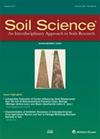Land use impact on carbon mineralization in well aerated soils is mainly explained by variations of particulate organic matter rather than of soil structure
4区 农林科学
Q2 Agricultural and Biological Sciences
引用次数: 6
Abstract
Abstract. Land use is known to exert a dominant impact on a range of essential soil functions like water retention, carbon sequestration, organic matter cycling and plant growth. At the same time, land use management is known to have a strong influence on soil structure, e.g., through bioturbation, tillage and compaction. However, it is often unclear whether the differences in soil structure are the actual cause of the differences in soil functions or if they only co-occur. This impact of land use (conventional and organic farming, intensive and extensive meadow, extensive pasture) on the relationship between soil structure and short-term carbon mineralization was investigated at the Global Change Exploratory Facility, in Bad Lauchstädt, Germany. Intact topsoil cores (upper 10 cm, n=75) were sampled from all land use types at the early growing season. Soil structure and microbial activity were measured using X-ray-computed tomography and respirometry, respectively. Differences in microstructural properties between land uses were small in comparison to the variation within land uses. The most striking difference between land uses was larger macropore diameters in grassland soils due to the presence of large biopores that are periodically destroyed in croplands. Grasslands had larger amounts of particulate organic matter (POM), including root biomass, and also greater microbial activity than croplands, both in terms of basal respiration and rate of carbon mineralization during growth. Basal respiration among soil cores varied by more than 1 order of magnitude (0.08–1.42 µg CO2-C h−1 g−1 soil) and was best explained by POM mass (R2=0.53, p<0.001). Predictive power was only slightly improved by considering all bulk, microstructure and microbial properties jointly. The predictive power of image-derived microstructural properties was low, because aeration did not limit carbon mineralization and was sustained by pores smaller than the image resolution limit (<30 µm). The frequently postulated dependency of basal respiration on soil moisture was not evident even though some cores were apparently water limited, as it was likely disguised by the co-limitation of POM mass. This finding was interpreted in regards to the microbial hotspots which form on decomposing plant residues and which are decoupled from water limitation in bulk soil. The rate of glucose mineralization during growth was explained well by substrate-induced respiration (R2=0.84) prior to growth, which in turn correlated with total microbial biomass, basal respiration and POM mass, and was not affected by pore metrics. These findings stress that soil structure had little relevance in predicting carbon mineralization in well-aerated soil, as mineralization appeared to by predominantly driven by the decomposition of plant residues in intact soil. Land use therefore affects carbon mineralization in well-aerated soil mainly in the amount and quality of labile carbon.土地利用对通气性良好土壤碳矿化的影响主要是通过土壤颗粒有机质的变化而不是土壤结构的变化来解释的
摘要众所周知,土地利用对一系列基本土壤功能(如保水、固碳、有机物循环和植物生长)产生主导影响。与此同时,已知土地利用管理对土壤结构有很强的影响,例如通过生物扰动、耕作和压实。然而,土壤结构的差异是否是土壤功能差异的实际原因,或者它们只是共同发生的,通常是不清楚的。位于德国Bad Lauchstädt的全球变化探索设施研究了土地利用(传统和有机农业、集约和粗放草甸、粗放牧场)对土壤结构和短期碳矿化之间关系的影响。在生长早期,从所有土地利用类型取样完整的表土岩心(上部10 cm, n=75)。分别使用x射线计算机断层扫描和呼吸测量法测量土壤结构和微生物活性。与土地利用内部的变化相比,不同土地利用之间微观结构特性的差异很小。不同土地利用方式之间最显著的差异是草地土壤的大孔直径更大,这是由于在农田中存在周期性破坏的大生物孔。在生长过程中的基础呼吸和碳矿化速率方面,草地的颗粒物有机质(POM)(包括根系生物量)和微生物活性均高于农田。土壤芯间的基础呼吸变化超过1个数量级(0.08-1.42µg CO2-C h - 1 g - 1土壤),最好用POM质量来解释(R2=0.53, p<0.001)。综合考虑所有的体积、微观结构和微生物特性,预测能力仅略有提高。由于曝气不限制碳矿化,并且是由小于图像分辨率极限(<30µm)的孔隙维持的,因此图像衍生的微观结构性质的预测能力较低。通常假定的基础呼吸对土壤水分的依赖并不明显,即使一些核心显然是水限制的,因为它可能被POM质量的共同限制所掩盖。这一发现被解释为微生物热点是在分解植物残留物上形成的,并且与散装土壤中的水分限制脱钩。生长过程中的葡萄糖矿化速率可以用生长前底物诱导的呼吸(R2=0.84)很好地解释,这反过来又与总微生物生物量、基础呼吸和POM质量相关,而不受孔隙率的影响。这些发现强调,土壤结构与预测通风良好的土壤中的碳矿化关系不大,因为矿化似乎主要是由完整土壤中植物残留物的分解驱动的。因此,土地利用对通气良好土壤中碳矿化的影响主要表现在活性碳的数量和质量上。
本文章由计算机程序翻译,如有差异,请以英文原文为准。
求助全文
约1分钟内获得全文
求助全文
来源期刊

Soil Science
农林科学-土壤科学
CiteScore
2.70
自引率
0.00%
发文量
0
审稿时长
4.4 months
期刊介绍:
Cessation.Soil Science satisfies the professional needs of all scientists and laboratory personnel involved in soil and plant research by publishing primary research reports and critical reviews of basic and applied soil science, especially as it relates to soil and plant studies and general environmental soil science.
Each month, Soil Science presents authoritative research articles from an impressive array of discipline: soil chemistry and biochemistry, physics, fertility and nutrition, soil genesis and morphology, soil microbiology and mineralogy. Of immediate relevance to soil scientists-both industrial and academic-this unique publication also has long-range value for agronomists and environmental scientists.
 求助内容:
求助内容: 应助结果提醒方式:
应助结果提醒方式:


